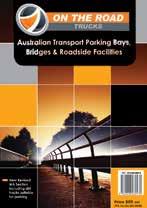
Joondalup








Joondalup






At the TWU, we are relentless in the pursuit of building and exercising worker power, guided by clear, strong principles. We are committed to earning and keeping our members’ trust and bargaining collectively. We aim to hold corporations to account, empowering the workforce with a strong and powerful voice.
The TWU has a number of Enterprise Agreements in a myriad of transport companies. If you work for a company that has an EA with the TWU, you, along with all transport workers benefit from the years of struggle and collective action of union members before you.

And set the standard for transport workers into the future.
TWU Members also benefit from a range of services available only to members
Legal Services
Wage increases and improved conditions through collective bargaining
Enforcement of your agreement and workplace rights
Representation for incidents or disciplinaries
Job Security and protection
$5,000 Funeral benefits
Free Wills
Extraordinary Driver’s License
Income Protection and Group Accident and Sickness cover
Collective purchasing power of UnionShopper to provide members with discounts on a range of restaurants, gift cards, white goods and more
You should be a member of your union, the TWU if you enjoy these benefits like:
Annual Leave
Maternity Leave
Long Service Leave
Sick days
Leave loading
Penalty rates
Superannuation
Health and safety and workers’ compensation
Allowances (meal allowances, shift allowances)
Rest breaks
Unfair dismissal protection
Becoming a member of the TWU ensures you can maintain these rights into the future.

Karen-Maree’ Kaye
T: 0430 153 273
Email: karen@angrychicken.com.au
Karen-Maree’ Kaye, Russell McKinnon
Jan Cooper, Cam Dumesny, Cliff Graham, Carol Messenger, Ray Pratt , Lara Jensen
ADVERTISING ENQUIRIES
Angry Chicken Head Office
T: 0430 153 273
E: karen@angrychicken.com.au
DESIGN / PREPRESS
Cally Browning | Bare Creative
ACCOUNTS
T: 0430 153 273
E: accounts@angrychicken.com.au
PRINTER
Daniels Printing Craftsmen
SUBSCRIPTIONS
Subscriptions available directly from the Publisher.
T: 0430 153 273
E: karen@angrychicken.com.au
Australia: 1 year $130 (inc GST)
Overseas subscribers: Airmail postage will be added to subscription rate.
Editorial Submissions: The Publisher welcomes editorial submissions. Once received they will become the property of the Publisher who reserves the right to edit the or adjust the content to fit with the format of our publication.
West Australian Transport Magazine (WATM) is published by Angry Chicken Publishing Pty Ltd
ABN: 35 486 530 095 All rights reserved. No part of this publication may be reproduced, adapted or transmitted in any form by any process (graphic, electronic, mechanical or storage and retrieval system) or sold, resold or otherwise exploited for any purpose without consent of the Publisher.
The publisher, contributors, editors and consultants disclaim any and all liability and responsibility to any person or party, be they a purchaser, reader, advertiser or consumer of this publication in regards to consequences and outcomes of anything done or omitted, or being in reliance whether partly or solely on the contents of this publication. No person, organization or party should rely on or on any way act upon any part of the contents of this magazine without first obtaining the advice of a fully qualified person. The Publisher shall have no responsibility for any action or omission by contributor, consultant, editor or related party for content within WATM. The opinions and content within WATM does not necessarily reflect those of the Publisher, editor or their agents. No responsibility is accepted for damage or loss of material supplied to the publisher.

Congratulations to everyone concerned at the LRTAWA for another successful Annual Conference – the 44th since their inception. Please see page 3 for a chance to win a brand new tri-axle drop deck trailer and pages 4 to 7 for all the news from the event and pictures of attendees and sponsors. Apologies we could not fit you all in. One of my favourite pictures is on page 6 of the LRTAWA’s CEO Jan Coopers beautiful daughter Sheridan looking terrified to say the least and we are glad she did not catch on fire.
This month the findings of the Austroads survey into international drivers was released and there were no surprises with concern from the transport industry on all the things we have been talking about that are lacking – training, driving skills, communication with other drivers, speaking English… the list goes on. This report will go on to all the powers to be in each state, however I am still concerned that the elephant in the room is not being addressed – which is there is no accountability for persons using the
graduated licensing system to actually gain practical experience and it is just based on ‘time’ holding the license. I hope someone in our government has the common sense to address this.
Meanwhile fatalities on WA roads are at an all-time high with the high percentage being in regional areas and sadly small children being the casualties. WA Premier Roger Cook has called for a Road Safety Crisis Meeting in Perth (Page 14 Western Roads Federation).
How proud all involved in the WA Mack Muster and Truck Show feel is an understatement – a whopping half a million donated to the Harry Perkins Medical Research. What a tremendous effort and testament to the kindness of our state’s transport sector. WA Transport Magazine has been thrilled to be a sponsor to the event from its inception and maybe we can make it to a million next time.
As always, thank you to everyone who supports the magazine.
Kindest regards,
Every Month




Joondalup Golf Resort came alive to the sound of trucks on the 3rd August when the WA Livestock and Rural Transport Association held its annual conference. In a change of format from the usual day and half event, the one-day program was structured to provide a mix of industry information and access to sponsor goods and services. Around 140 people attended from across the state and were treated to a beautiful sunny day which is a departure from the deluge that has so often accompanied LRTAWA conferences.
In welcoming delegates to the conference, President Darran Bairstow, drew attention to several issues that stood out as having major impacts on members. He highlighted the Closing the Loopholes Bill. The LRTAWA opposed the road transport specific provisions of this Bill on the basis that there is no role for the Fair Work Commission in regulating commercial relationships involving rural transporters and their clients and between other transporters. The Association argued strongly that rural transport has a unique structure typified by a series of short verbal contracts undertaken on a daily basis. An
exemption for rural transport was sought. The end result was an agreement to exempt livestock transport via regulation and the push to have general rural transport exempted will continue.
The second issue was the Federal Government’s decision to phase out live
sheep exports by sea by May 2028. Mr Bairstow said that the Association heard loud and clear from members that they wanted active and vocal opposition to the policy. He pointed out that the damage to the industry, which he stressed was more than just livestock and included those that cart fodder, hay and fertiliser, has already started to take effect. He said the LRTAWA would keep fighting for a better deal for our members and to ensure that cattle live export does not go the same way.
Mr Bairstow also drew attention to the announcement in July that heavy vehicles signs would be changed. He said ‘we can back initiatives to improve safety, but sometimes what you see is not what you get’.
The changes to Heavy Vehicle signage requirements were a hot topic during the Main Roads WA session. Chief Operating Officer Des Snook made note of the ministerial reference group that has been created to have a closer look at the challenges presented by the change. Director Heavy Vehicle Services, Mike Buba congratulated livestock transporters for their high level of compliance judged through results from heavy vehicle inspector intercepts.
The closure of parking bays, particularly
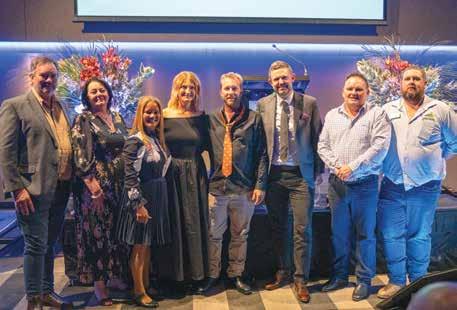

The LRTAWA greatly appreciates the support & ongoing commitment of the following sponsors at the 44th Conference.

ATSURE Pty Ltd
Ausquip Industries
Bunbury Tyrepower
CJD Equipment
Daimler Trucks
Perth
EVERTRANS
Fuwa K-Hitch
General Transport Equipment
HENDRICKSON
Asia Pacific
JOST Australia
K Craft Bullbars
Swan Towing
Truck Centre WA
TRUCKLINE
WA bandag Pty Ltd

THANK YOU TO THE FOLLOWING 2024 SPONSORS
ALCOA WHEELS
CAPRICORN SOCIETY
CITY PANEL
BEATERS TRUCK REPAIRS
Fuel Distributors of WA
Great Southern Fuel Supplies
KRU Engineering
MICHELIN Australia
V-DAQ Pty Ltd
WESTERN TYRE FORCE
AIR BRAKE CORPORATION
All Truck Spares
BMS Risk Solutions
Global Autocoat
Lake Grace Tyrepower
Orrcon Steel
SAF Holland
SCANIA Australia
12 Volt World
Albany
bp Australia
Byrne Trailers
Cummins South Pacific
National Transport Insurance
PACCAR & Dealer
Industry Fund
POWER TORQUE Magazine Repco
COMMERCIAL
Lowes Petroleum
Equipment Finance Services Pty Ltd
THE VOICE OF WA RURAL TRANSPORT SINCE 1980 — PROMOTING SAFETY, PRODUCTIVITY & EFFICIENCY

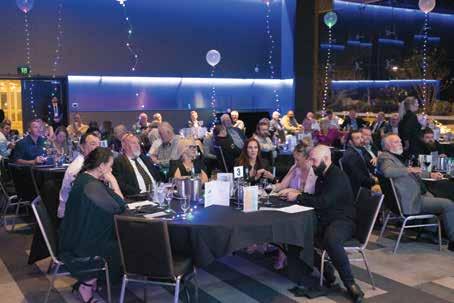

along the stretch of Albany Highway between Kojonup and Albany was a contentious issue as was the lack of rest area for truck drivers near the new Albany Ring Road. A facility that was promised has not eventuated. A planned expansion of the Muchea Road Train Assembly Area, however was welcome news.
The predictions for the sheep flock from well-known agricultural analyst Matt Dalgleish did not provide much good news. Mr Dalgleish said that just under half of WA’s producers indicated they would exit the industry as a result of the phase-out and around 40% of transporters said they would exit the industry altogether. He said although he wasn’t a supporter of the phase-out there were opportunities for an orderly transition away from live export over a 12-year period that would soften the blow to producers and the supply chain but it cannot be done in four years without serious negative consequences.
Mr Dalgleish warned the WA sheep flock is projected to decline by 40% in 2024/25 which means it will drop below the 10 million mark - this is considered the level below
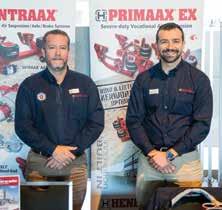


which there will be supply chain impacts.
It’s been a tough year for our members and their clients. Comments from Terry Melrose from Regional Men’s Health to talk to a mate resonated with the group in light of their recent experience. He said finding a person you trust – a partner, a mentor or a peer to talk to on an intimate level was important.
In a similar vein, Former Tactical Response Group member, Todd Bowler finished the day with his presentation about

working in high risk situations and the leadership and resilience skills he learned. Todd referred to the debriefing that took place following significant tactical response events and the comparison between what could be confided in a partner compared to work mates. He said two of the key aspects of his tactical response role were mission focus and finding 1% more to push through. Both ideas found fertile ground with transporters.
The day concluded with an entertaining demonstration of whip cracking from



Walter Whip and the Flames direct from Queensland. With some trepidatious audience participation, he managed to wow onlookers as he wielded and cracked a flaming whip.
In the evening at the gala dinner the auction of sponsor goods and services was held which is the main fundraising activity for the Association. The traditional auction for the Perth Children’s Hospital Foundation raised an astounding $37,000. The total amount raised through this event has now reached $140,000.
Earlier in the day at the annual general meeting, Ben Sutherland was elected president with Glen Linklater, livestock vice president and Timm Lange, rural vice president. The secretary is Peter Warburton and the treasurer is Wade De Campo.
The LRTAWA is extremely grateful for the ongoing support of sponsors. Without them the Association would be unable to represent members and strive for a safe and productive transport industry.






At the end of July, the WA Mack Muster and Truck Show team and their sponsors gathered at the Harry Perkins Institute of Medical Research to hand over a cheque for half a million dollars to the Chief Executive Officer of the Harry Perkins Institute (or the Perkins), Professor Peter Leedman AO.
Committee Chair, Steven Della Bona said, “The inaugural Western Australian Mack Muster and Truck Show raised $100,000 for medical research for the Perkins in 2020, then an impressive $250,000 in 2022. The 2024 goal was to match the 2022 contribution so we’re over the moon to be able to donate $500,000 in 2024 and help Professor Leedman and his team bring us closer to a cancer free future”.
“I am overwhelmed by the generosity of the WA Mack Muster and Truck Show community and the work they have done to raise these vital funds for medical research in WA. Cancer is a terrible disease and sadly it will affect almost of half of us in our lifetime. I am so grateful for this support which will go a long way to help WA’s best researchers find kinder treatments, and give us all the best chance at longer, healthier lives,” said Professor Leedman.
WA’s premier truck event - the WA Mack Muster and Truck Show, proudly pulled off its third edition of the event on Sunday, March 2024. Set amongst 200 beautiful acres at Quarry Farm, just 40 minutes South-East of Perth, the much-anticipated biennial

event was a huge success with over 8,500 people turning out to view more than 330 outstanding trucks, dozens of trailers and industry displays, in a wonderful community spirit.
“The WA Mack Muster and Truck Show had become Perth’s premier truck show event where the industry unites and brings the community together for a wonderful cause. We’re really proud of the Transport industry and what it does for our nation, and it is special to see everyone gathered around together for a great cause in helping us all move closer to a future where Cancer is nonlethal,” said the events lead organiser, Matt Lawrence.
With all proceeds from the show going towards the total donation, everyone who purchased a ticket to the Truck Show in March has made a meaningful difference towards finding solutions to the hardest to treat Cancers at the Harry Perkins Institute for Medical Research.
The transport industry’s generous support included proceeds from the pre-show gala dinner and auction on the Friday prior where sponsors and industry dug deep for this great cause.
The WA Mack Muster and Truck Show is a biennial event with the next show set for early 2026.
Follow the WA Mack Muster on socials @WAMackMuster and www.facebook.com/wamackmuster and instagram.com/ wamackmuster) for the latest announcements and behind-thescenes insights.


In May 2024 Main Roads Heavy Vehicle Services advised that the Intelligent Access Program (IAP), administered by Transport Certification Australia (TCA), is being replaced by the Telematics Monitoring Application PBSWA (TMAPBSWA) for monitoring Restricted Access Vehicles approved under the WA Performance Based Standards (PBS) Scheme.
Several other jurisdictions have already replaced IAP with alternatives for vehicle monitoring and the steady decline in the use of IAP nationally means the future of IAP is now uncertain. As such, we have worked with TCA to develop TMAPBSWA, which was introduced midway through 2023 as a potential interim replacement for IAP.





and
Since that time, PBS operators have been able to nominate either IAP or TMAPBSWA to have their approved PBS vehicles monitored, resulting in a steady increase in vehicles enrolled under TMAPBSWA. This has enabled us to determine TMAPBSWA to be a suitable replacement for IAP.
Since May 2024, PBS operators are required to enrol all new PBS vehicles under TMAPBSWA via their TCA Certified Service Provider. Existing PBS vehicles enrolled under IAP can continue to operate as normal whilst IAP remains available. However, we encourage PBS operators to contact their Service Provider to discuss transitioning their existing PBS vehicles over to TMAPBSWA.
As operators transition their PBS vehicles to TMAPBSWA, they will need to contact Main Roads and advise us accordingly.
For further information please visit www. mainroads.wa.gov.au/heavy-vehicles/permitorder-scheme/PBS/ or contact the WA PBS team on 138 486 or email hvsnetworkaccess@mainroads.wa.gov.au




From major truck workshops, heavy haulage, cranes, the mining industry and more… our team of knowledgeable and qualified technicians share over 100 years combined experience and focus on delivering prompt service alongside the supply of top name brakes and clutchesthroughout Australia and Asia.
With over 20 years in the industry we have a well-earned reputation for the development, manufacture and supply of quality standard and customised designs to suit a wide range of applications.
For the best advice and friendly service contact us today.
+61 8 9353 4411 ■ sales@knightbrakeandclutch.com.au knightbrakeandclutch.com.au







Over to you
A

Far too many of our experienced truck drivers are reporting they are increasingly worried about sharing the roads with unskilled truck drivers.
I’ve written several times now about the need for better training and education as we try and fix our truck driver shortage however, it is no secret - we have seen a decline in the standards of truck drivers and the motoring public in general.
The general consensus is our licensing system is failing our drivers and people in general are more stressed as they struggle with today’s lifestyle – and this is flowing onto our roads.
No-one, even blind Freddy can ignore the plethora of daily truck accidents and incidents.
Some good news is that some transport associations are started to acknowledge the benefits of training new truck drivers to a higher standard with better skills and are calling on the government to implement changes. The sooner it is recognised that driving a truck is a skilled profession, the better.
However, this is doing nothing to address the immediate problem – the unskilled drivers that are already on our roads who are putting their own and other’s lives at risk.
We can all recall the really close calls we’ve had on the roads with other motorists so it just comes down to when do we say we’ve had enough, which is sadly what many truck drivers are doing.
It’s far too easy to pass a driving test
and obtain a driver’s license for a car or a truck but that license does not make a competent driver.
Learn as you go seems to be the normal training route for most, and this may have worked decades ago when there was fewer traffic and lower powered vehicles but it is not the answer now and simply there needs to be legislated training with a ‘qualified’ trainer to gain the necessary skills before drivers are let loose on the road.
Two incidents come to my mind regarding untrained drivers driving road trains.
The first was a road train with two trailers going to a north-west mining town. It was the driver’s first trip and he admitted he was out of his comfort zone as he had no road train experience.
He made it to the depot but was unable to drive through the front gate to get unloaded. The transport company drove his truck into the yard for him – unloaded, reloaded and drove the truck back onto the road facing his way home. He departed and said that he would not be back and hopefully he would be able to get home safely - which he did. Is this the sort of truck driver we want to share the road with?
The second incident happened in the Goldfields. I came around the corner to see a quad road train parked on the side of the road with its back trailer on its side and ore all over the road. I stopped to check the driver was ok and he told me his story…
He worked for a large reputable haulage
company as a mechanic servicing huge quad road trains but he did have an MC license. This particular day the company was short of drivers so they asked him to take the truck out and get a load of ore which he was reluctant to do but felt compelled to help out even though he lacked the necessary experience.
He drove several hundred kilometres to the mine site where he got loaded and headed back home. Half an hour later, he encountered a road train from the same company coming towards him so he moved over to give him room. Sadly he moved over too much and flipped the rear trailer on the edge of the sealed road. He wasn’t happy and explained that he probably would not have a job once he got home.
You would find it hard to fathom why in both these cases an inexperienced driver would be allowed to go on the road without the necessary skills.
What on earth were the supervisors who allowed them on the road thinking? Would they have been held culpable under the Chain of Responsibility if there had been a fatality or property damage?
The licensing and training system we have is obviously not working but I am convinced that government departments and bureaucrats are oblivious to this fact.
It’s a shame that truck accidents are not investigated and analysed by WorkSafe.
After all it is an accident in our work place. Keep it safe, Ray Pratt.














Victoria 13-21 Bliss Court, Derrimut VIC, 3026
Tel -(03) 9369 0000
Queensland 1/15 SeeanaPlace, Heathwood QLD, 4110
Tel -(07) 3372 2223



Western Australia 5 Freight Road, Kenwick WA, 6107
Tel -(08) 9350 6470

With limited transport networks connecting Western Australia with the rest of the country and the vulnerability of weather disruptions that affect freight movement, the state has experienced many times where supermarket shelves have had empty spots.
Once road freight does arrive from the east coast, road trains are required to break up loads at the RTAA in Northam and make multiple trips to deliver the loads down the ‘dog run’ to their destination in Perth, whilst adhering to mandatory rest breaks. This process can take up to three days.
In a report from TM Insight in 2019, it was found that driving a three-trailer road train cost $4000 per day, meaning one round trip from Northam to Perth at that time cost $12,000 per trip.
This inefficient and expensive procedure is being addressed by a consortium led by Procon Developments who are developing the AvonWest logistics and enterprise center in Northam. They have purchased the existing Main Road Train Assembly Area, which is anticipated to double in size to meet growing demand.
They plan to establish container servicing, truck maintenance and tyre serving facilities within the 60-acre estate and also own the Atlas Fresh Trading Co Northam Service Station which is next door to the development and offers a shop, restaurant, toilets and showers, plus they plan to build a 50 room accommodation facility at the location early 2025.
Speaking to Stockhead, Procon’s WA development director Mark Hardy WA said the center’s development plans were driven
solely by the goal of increasing efficiency in freight and logistics.
“Our idea is that logistics companies and/or end users bringing goods will come and unload their trucks. Meanwhile, cargo heading back east is loaded onto a road train and the driver takes a mandatory break before returning east,” he explained.
“This saves them having to travel back and forth to Perth, allowing each road train to make more journeys each year.
“The attraction for us and WA is to provide some sort of supply chain and food security as it enables each truck to make about 15 extra trips a year.
“Each truck carries approximately 110 tons, 16 trips equals 1,600 tons per truck, with more supplies coming into the state every year.”
This references similar road train assembly sites in eastern states that are located outside cities.
A 2019 study found that the transport hub, to be built on a 63ha plot at the corner of Yilgarn Avenue and the Great Eastern Highway, which already contained an MRWA–RTAA assembly area, would reduce line transportation costs by $540,000 per year for one road, train and improve resource utilization by up to 50% in one year with 60 trips per year.
The hub will also reduce last-mile transportation costs from 6% to 56%, equating to savings of $272,790 per year based on approximately 20 deliveries per week from the fulfilment center.
Additionally, it will increase speed to market from 24 to 48 hours, significantly improving the safety of both trucks and cargo carried by RTAA.
The development of this important piece of infrastructure will also significantly improve driver comfort, as the current RTAA located in the estate is a primitive, unsecured area, devoid of modern amenities to support truck drivers and road trains.
Such investment will also contribute to ongoing efforts to transform Northam into a logistics hub, with CBH Group investing tens of millions to upgrade its Meenar facility at Avon Industrial Park to make it one of its largest grain collection sites.
The planned Procon logistics center will offer logistics companies the option to lease or purchase the blocks, with Hardy emphasizing that the Environmental Protection Authority has already given the green light.
It will be a carbon-neutral logistics park with its own micro-network and water treatment plant on site. Approximately 350,000 m2 of solar panels will be placed on roofs and this solar energy will placed into backup batteries so there is power 24 hours a day, 7 days a week. There are also plans to install electric truck chargers and companies will be able to issue carbon credits simply by being located at the facility.
It is not all clean sailing for this project which has been held up by red tape regarding issues of water main servicing the estate.
However, in a HVS update it was reported that the land surrounding the Northam Road Train Assembly Area is being developed and construction site fencing is currently being erected at mainroads.wa.gov.au/heavy-vehicles/ updates/hvs-updates/26-2024/
The construction of five new overtaking lanes (three northbound, two southbound) between Newman and Munjina (Auski) on the Great Northern Highway is expected to be completed later this year.
A further six overtaking lanes between Munjina (Auski) and Port Hedland as part of a second stage will also commence construction later this year.
A total of $50 million has been allocated to deliver the 11 the overtaking lanes under the Roads of Strategic Importance program, which is jointly funded by the Australian and WA Governments.
With more than 60 per cent of traffic between Newman and Port Hedland comprising of heavy vehicles, the new lanes will enhance the existing freight network, increasing transport efficiency and improving road safety.
A further $29 million is also being invested to seal the shoulders and install audible edge lines to more than 150 kilometres of the Great Northern Highway
between Kumarina and Newman.
The works are being delivered as part of the State Government's landmark $1 billion Regional Road Safety Program, which will see safety upgrades delivered to around 10,000km of the State's regional road network by the middle of 2025. Eight hundred kilometres of road network in the Pilbara has now been upgraded through the program.
Both projects come on top of a number of completed freight productivity improvements in the Pilbara region.
The $21 million worth of improvements were delivered through Stage One of the Freight Vehicle Productivity Improvements Program and focus on amenity and safetyrelated projects including:
• Great Northern Highway, Newman (Road Train Assembly Area) - sealed parking area, installation of ablution block, lighting and line marking;
• Great Northern Highway, Munjina (Auski) - sealed parking area and improved access for heavy vehicles;



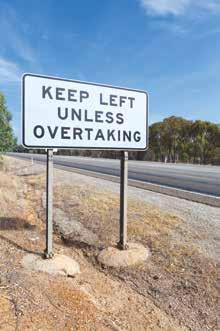
• Great Northern Highway, Karijini Drive - upgraded heavy vehicle rest area, provision of shelter, benches, lighting and ablution block;
• Great Northern Highway, Redmont (Road Train Assembly Area)installation of modern ablution block;
• Great Northern Highway (Area C), heavy vehicle rest area - installation of modern ablution block; and
• Great Northern Highway, Bell Street (Road Train Assembly Area) - installation of modern ablution block.
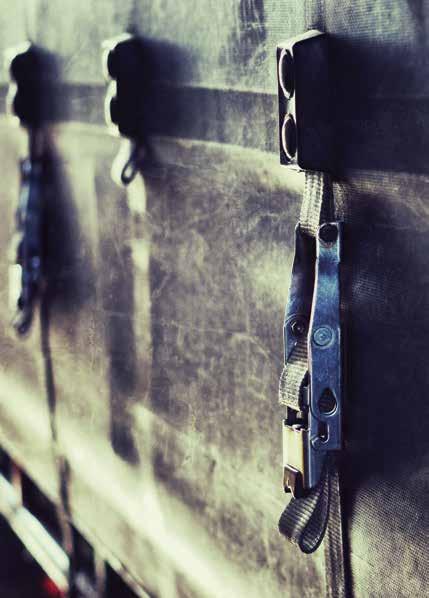

Cam Dumesny, CEO
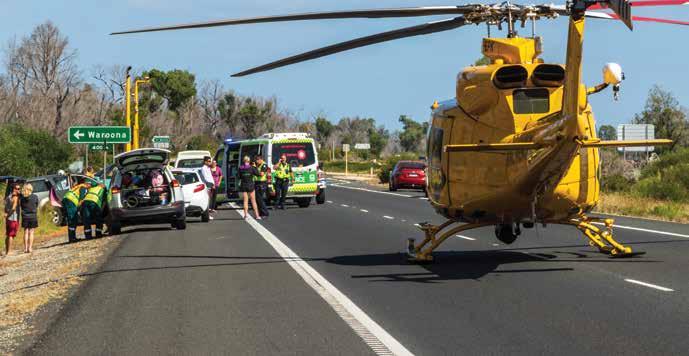
During August, the Western Australian Premier called for a Road Safety Crisis Meeting, which Western Roads Federation supports, given the increasing road toll.
Look at the tragic events over the beginning of August. A young toddler very sadly died in an accident near the Port Hedland. Meanwhile a person is shown holding a baby in their arms whilst driving on a Perth Freeway. In Melbourne two toddlers in nappies on the road near an accident with reports saying they were unrestrained in the car.
Last week I drove back from Sydney to Perth to check on the driving issues and road quality. I regularly do the drive;
I prefer it to flying and yet increasingly it does my head in at just how bad the roads have become and even worse - the blatant stupidity of some drivers.
National Road Safety Strategy has failed
The National Road Safety Strategy 2021-30 sets out Australia’s road safety objectives over the next decade and includes key priorities for action and targets to reduce the annual number of fatalities by at least 50 per cent and serious injuries by at least 30 per cent by 2030.
Yet, in the last five years, the national road toll has risen over 20% from 1102 people in FY 19/20 to 1327 FY 23/24. Sadly
Athe road toll has fairly consistently risen each of the five years. (Source: Federal Bureau of Infrastructure and Transport Research Economics – 14 Aug 24)
So rather than reducing fatalities the sad reality is that they are continuing to rise year each year.
So what’s wrong?
The left leaning Grattan Institute was reported in The Guardian in 13 Nov 23 as saying, “Regional Australian roads have become a “dangerous disgrace”, according to a new report that warns they will get worse due to paltry funding that favours cities and forces poorer regional councils to
ccording to the state government, there have been 117 fatalities in WA road crashes this year — the highest number since 2016.
69 of those deaths have been on regional roads.
The fatalities in the first two weeks in August prompted Western Australian Premier Roger Cook to ask the Minister for Road Safety David Michael to convene a meeting with road safety peak bodies to discuss the recent spate of fatalities.
“To see what else we can do as a community to drive down the incidents of fatalities and accidents in our community.
“It seems an almost daily occurrence now that we’re reporting [to] another death on
It seems an almost daily occurrence now that we’re reporting [to] another death on our roads
our roads,” Premier Cook said.
Police have charged a South Hedland man with one count of manslaughter and two counts of dangerous driving when a three-year-old girl was killed in a car crash in WA’s north while several adults were also injured.
A crash that killed a toddler in the Pilbara region is being investigated by police. Just before 11pm, a Holden Captiva
left the road near the Great Northern Highway at De Grey, near South Hedland, and rolled. Major Crash officers have travelled to the Pilbara to examine the scene and have asked for any witnesses to contact Crime Stoppers.
It came just days after three people, including a baby boy, were killed in a single-vehicle rollover in WA’s Mid-West.
A 36-year-old man also died after his van collided with a truck on the highway connecting Geraldton and Exmouth.
“My heart goes out to the families and all involved, and the first responders who would have had to … see these very distressing scenes,” said Premier Cook.
waste repair money erecting signs in tribute to government grants.
“In a new report, the Grattan Institute has found that roads across the country have become riddled with potholes and other hazards because inadequate federal and state government funding has left councils under-resourced and without sufficient knowledge or data to maintain the roads they are responsible for.”
The blunt reality is more people are dying on regional and remote roads, yet more funding is going into political vainglorious capital city infrastructure projects across the nation.
Driver Attitude
You don’t have to drive for too long on a road or spend too long on social media to see examples of absolute driver stupidity and arrogance. How do you fix that?
Road User Mix
The increasing number of caravans on the road and the increased size and weight, begs the question should Caravan Drivers be separately trained and licensed. Note I intend to buy one when I retire.
Should we organise for Truck Drivers to teach at these caravan training sessions?
What to do about cyclists on remote highways? I will be honest If I was fit enough (not going to happen) it would be good to do. But let’s say I was good enough to ride across the Eyre Highway, yes I am legally able to do it, ‘but should I’? I am happy to work with the Cycling groups on solutions.
Ok, lets start with the Elephant in the Room. We need foreign drivers ‘but they must be’:
• Independently Verified as Competent to
Drive the Combination their Licence States
• Trained in Heavy Vehicle Regulations
• Trained in On-Road Safety Culture. Ie all those things truck drivers do, that are not written in a book that make it safer and more courteous to other Truck Drivers.
This position originally developed by Western Roads Federation has now being picked up nationally, except for Victoria who seems to want open slather.
Due to word limits I haven’t discussed other essential things like increased and improved rest areas.
Reducing regional airfares so families can afford to fly rather than being financially forced to drive.
Increasing on Road Police presence, note I only saw two Police Patrol cars in 2000 km on the last trip.
What about the increasing reports of poorly maintained heavy vehicles on the road, how would you fix that?
What are your ideas? Email them to me at cam.dumesny@westernroads.com.au

Western Roads Federation has been formed to give a strong unified voice for companies who use WA roads for commercial benefit.
Western Roads Federation is a membership driven organisation. If you believe in the industry and what you do, then make sure your company is a member, and get involved.
By Cliff Graham

ADo
skit has been circulating around on social media where a professor asked a girl in his class to leave immediately, without any explanation whatsoever. He then asked the rest of the class, “Why are there laws?”
A few answers were thrown around until someone said ‘justice’.
The professor then asked, “Was I unfair to your classmate, just now?” The whole class agreed that he was to which he replied, “Indeed I was. Then why didn’t any of you protest? Why didn’t any of you stand up against the injustice happening? The truth is nobody gets involved unless it
directly involves them.”
This leads me to ‘selfish’ drivers who can also be summed up as arrogant, inconsiderate and can be the cause of impatience in other road users.
Whilst driving livestock road trains I have caught up to too many convoys of two or more vehicles travelling 20 or more km’s below the speed limit with less than 20-30 metres between them. Many are grey ghosts and I acknowledge they have every right and privilege to be on the road.
They however make it impossible for a road train to over-take them one at a time so we wait until there is a really long, clear,
TWhen you get to where you can pass them safely and build the road train up to the necessary speed the impatient car This is ‘The Outback’

straight stretch of road to do so whilst they seem oblivious to the build-up of traffic behind them which includes trucks and cars.
You sit there wondering if they ever look in their mirrors, or are their mirrors extended so they can see past what they are towing.
Some states have laws called, ‘Driving without due consideration for other road users’. In WA, it comes under ‘Driving without due care and attention’.
he WA State Government has reached a major milestone towards developing a job-creating clean energy hub at Oakajee, with the contract awarded to deliver the new precinct access road.
The access road is an important step towards unlocking the Oakajee Strategic Industrial Area and positioning Western Australia as a global renewable energy powerhouse.
The $20 million road contract has been awarded to Highway Construction Pty Ltd, with works to start in coming months.
The project includes a new intersection at North West Coastal Highway,
construction of the first stage of the access road, and around four kilometres of highway widening in the area, with new acceleration and deceleration lanes to be built.
The upgrades will support heavy freight movements in and out of the industrial area, and are due for completion later next year.
The Oakajee SIA is located around 20km north of Geraldton and is recognised for its world-class wind and solar potential, making it ideal for clean energy industries.
The Cook Government has prioritised developing WA's SIAs to create jobs and
drivers behind you kick in and try and overtake everything in front of them. There’s a very good quote from a movie, “People only do stupid things because we let them get away with it”.
The trouble is too many people are dying on our roads and it seems that nobody really cares until it happens to them or affects them personally.
I don’t understand why those towing caravans are not given formal training on interacting with other road users and correct loading. How about driving on dirt roads and I’ll go as far as to say many can’t even reverse them.
I lost count of the times when transporting oversized mining equipment with pilots or police escorting when ‘they’ would have to get in and reverse caravans back off floodway’s because the caravan defied the front pilots request to pull off the road before a culvert or floodway because a nine metre load was coming. All the while traffic behind the load is accumulating.
Occasionally I’ve had police ask us (myself and accompanying pilot vehicles) to pull over while they go back and give people infringement tickets for not even slowing down after being instructed by police to pull over, because there’s a wide load coming.
There are also distance restrictions on how far a wide load can travel before pulling over to let the traffic clear behind it. It used to be 20 minutes or 20kms. Why isn’t there these same courtesy regulations regarding slow caravaner's and I will never understand those who speed up when you are trying to overtake them. Is it arrogance or are they just unaware because they can’t see what is behind them because their mirrors are not extended?
diversify the State’s economy.
As part of the 2024-25 State Budget, the Cook Government announced the $500 million Strategic Industries Fund, which will fund common-user and other enabling infrastructure at the State’s 13 SIAs.
The Cook Government has also put in place a $160 million industrial lease incentive scheme to attract clean energy projects to SIAs.
Premier Roger Cook said, "Under my Government, Oakajee is on the path to becoming one of the State’s major clean energy jobs precincts.
"Through the new access road, the $500
The arrogant people think the chances of getting caught are slim so it’s worth the effort of doing whatever they want without any consideration to other road users to get to their destination
I had a mate call me up on the radio whilst driving a prime mover bobtail as he trying to overtake a slow moving caravan in an overtaking lane after following them for the past ten kms.
Being bobtail it was instantly up to 100 kph once on the overtaking lane only to have the caravan driver speed up also. It took the entire overtaking lane to pass one caravan leaving a build-up of traffic stuck behind. The caravan driver was completely unaware of what was behind him as there were no extended mirrors fitting to their vehicle.
If a slower vehicle gets to an overtaking lane they ‘should’ show respect for the build-up of traffic behind and slow down to ensure every vehicle behind overtakes safely. Is that not the purpose of overtaking lanes?
Months ago I was heading south in a loaded cattle road train – travelling slower and more cautiously for the animals welfare and caught up with a couple of slow moving caravans travelling close together. The cattle also don’t need to be on the road longer than is necessary because other road users have no consideration.
I called them up many times on the two-way to negotiate a safe and practical
The
upgrades
will
support
heavy freight movements in and out of the industrial area, and are due for completion later next year
million Strategic Industries Fund and our lease incentive scheme, we’re turning the Oakajee dream into a reality.
“Developing Oakajee will create thousands of long-term jobs for Geraldton, diversify the Mid West economy and help
solution to no avail and had to back off to the same speed. At one point I had two four wheel drives overtake me then sat behind the convoy of caravans until the next overtaking lane which was too short so they had to go over the speed limit to get past them. Then I see a police car, coming in the opposite direction that proceeded to pull up these two four wheel drivers for speeding.
These police were more interested in someone doing 5-10 kph over the speed limit and completely disinterested in the dangerous incompetence and inconsideration of the caravan drivers who were following too close to the one another causing the massive build-up of traffic behind them for the last 80 kms.
So why aren’t more of the other laws and regulations/road rules policed or is it pick the easiest revenue?
Speed cameras aren’t doing anything about dangerous driving out on the open road and it’s a shame to say it, but we need more police presence on the roads. The arrogant people think the chances of getting caught are slim so it’s worth the effort of doing whatever they want without any consideration to other road users to get to their destination.
WA to become a global renewable energy powerhouse.”
Transport Minister Rita Saffioti said, "This is an important first step for our future Oakajee SIA, and importantly, will provide a safer road environment for the heavy freight vehicles that will operate in the area.
“Oakajee is one of 13 SIAs attracting important investment into Western Australia to grow emerging industries.
“Of course, these SIAs not only provide massive economic opportunity right across the State, but will also create more longterm jobs for Western Australians.”
Ground has been broken on the Lumsden Point Access Road and Pinga Street intersection upgrades to support the Pilbara Hydrogen Hub at Port Hedland on the north coast of Western Australia.
The road and intersection work at Lumsden Point will support the import of wind turbine and renewable energy components into the Pilbara, as well as the export of battery metals such as lithium and copper concentrates.
To complement the Lumsden Point development, a new grade-separated rotary interchange will be constructed at the current intersection of Great Northern Highway and Pinga Street.
Two new single-span, 15-metre-long structures, with four lanes over a round underpass will connect Pinga Street to the new Lumsden Point Access Road.
New ramps will allow access on and off the Great Northern Highway, with new turning pockets to be built at the Lumsden Point Access Road.
The new intersection will improve traffic flow and reduce congestion at Lumsden Point and Pinga Street, while also facilitating the safe movement of oversize vehicles out of Lumsden Point.
In February, the Australian and WA Governments finalised a $140 million agreement to build a hydrogen hub in the Pilbara.
The combined $140 million investment ($70 million each from the Australian and WA Governments) will help build infrastructure to support hydrogen exports as well as fund activities for a Clean Energy Training and Research Institute.

Workplace Relations Assist is a program of services to help employers understand and comply with changes to Fair Work Laws. The program is funded by the Australian Government Department of Employment and Workplace Relations through the Productivity, Education and Training Fund grant program.
Significant changes to workplace relations laws are being implemented through three tranches of legislative amendments.
Tranche 1 – the Secure Jobs, Better Pay amendments, which introduced changes including multi-enterprise bargaining, new rules around enterprise agreement making, bargaining disputes, employee requests for flexible work arrangement, and the use of fixed term contracts and pay secrecy requirements;
Tranche 2 – the Protecting Worker Entitlements amendments, which introduced changes including to unpaid parental leave arrangements, the
implementation of superannuation entitlement under the National Employment Standards, and changes to authorised payroll deductions; Tranche 3 – the Closing the Loophole Bill, which proposes major changes relating to the use of labour hire and similar arrangements (the same job, same pay provisions), new rules and restrictions on the engagement of casual employees, changes to the engagement of independent contractors, the regulation of road transport industry supply chains, and changes to union ‘right of entry’ and ‘delegate rights’
Many of these changes have recently commenced operation, while others are either set to commence in the near future or still being considered by Parliament. To sign up to access the complimentary IR services for employers visit www.aigroup. com.au/resourcecentre/fair-work-legislationchanges/workplace-relations-assist/
The Australian Government must include truck drivers in its planned road safety campaign, ATA Chair Mark Parry said.
The Government provided $10.8 million for the campaign in the 2024-25 Budget.
Mark said the trucking industry’s safety had improved markedly over the decades, but the National Truck Accident Research Centre’s 2024 major incidents report, released this week, raised concerns.
“Our industry is much safer than it used to be. For example, there were 56 fewer fatal crashes involving articulated trucks in 2023 than in 2003,” Mark said.
“The increase in safety is even more marked when you consider that the number of articulated trucks on the road
The report found that driver inattention or distraction incidents have increased since 2022. Incidents due to inappropriate speed have increased, as have incidents involving tailgating
almost doubled from 2003 to 2023.
“But the NTARC 2.0 report highlights issues we must address. The report found that driver inattention or distraction incidents have increased since 2022. Incidents due to inappropriate speed have increased, as have incidents involving tailgating.
“These findings show that the Government’s planned road safety campaign needs to reinforce good safety practices by truck drivers as well as car drivers.
“We all need to be reminded to pay attention, slow down and stay back from the vehicle in front.
“The growing number of alerts from in-cab technology is also a distraction issue. Drivers need alerts that are urgent and important – such as warnings about drowsiness or lane keeping – but don’t need unimportant alerts while they are focused on driving,” he said.
Mark also urged the Government to support businesses to bring forward fleet upgrades to trucks with the latest safety technologies.
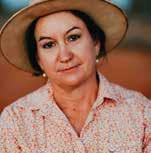

By LARA JENSEN
Last month the families of rail crash victims around Australia I represent in collaboration with politicians Melissa Price MP and Merome Beard MLA launched a petition calling for mandatory train illumination standards. The petition was borne out of our sheer frustration with decades of inaction, constant stonewalling by the rail industry and a reluctance by the Office of the National Rail Safety Regulator, (ONRSR) to drive the safety lighting changes needed to bring the rail industry out of the dark ages (literally) and into the 21st century. The petition garnered 6601 signatures in one month and was amongst the most supported petitions for this Parliament.
I have looked on in recent months with serious concern as to the directive coming from national rail safety regulator, ONRSR that is responsible for regulatory oversight of rail safety in Australia.
What I am observing is none other than ‘regulatory capture’, a metaphor coined by American economist and Nobel laureate, George Stigler in 1971. Regulatory capture
is when a regulatory agency created to promote public interests, instead prioritizes the commercial interests of the industries they are charged with regulating.
ONRSR is supposed to be an independent regulatory body responsible for protecting public safety, yet it is aligning itself closely with rail operators. To give just one example a recent LinkedIn post the ONRSR posted a photo promoting the Aurizon safety campaign “Respect the sign. Lives are on the Line”.
The ONRSR post reads, “ONRSR is taking every opportunity to support initiatives that raise awareness of the shared responsibility of safety at Australian level crossings”. By this, what they really mean is they support ‘driver education campaigns’ like the ones rail operators Aurizon and Pacific National along with the Australian Government have conceived and rolled out in recent months that apportion blame squarely on the regional motorist while absolving rail operators from doing anything whatsoever to improve train illumination.
Alarmingly, there is no publicly available information about ONRSR’s activities to improve public safety, or the results of its activities. If the regulator ONRSR was genuinely concerned about public safety it would insist that rail operators improve the standard of visibility of their trains and rolling stock in line with coronial recommendations, research and the findings of numerous committees and enquiries over the decades that all reinforce the importance of improved train lighting at unlit regional crossings.
But this is not the case, as outlined in the Hansard transcript for the Rural and Regional Affairs and Transport Legislation Committee dated 29th May 2024, when ONRSR CEO Dr Natalie Pelham presented evidence specifically relating to train illumination.
Dr Pelham stated that ONRSR had commissioned two separate pieces of research that found upgraded train lighting significantly improves the visibility of trains at night, particularly for vehicles approaching level crossings at obtuse angles.
When questioned if ONRSR was going to recommend flashing lights for trains operating at nighttime, Dr Pelham responded that ONRSR would suggest rail operators ‘consider’ it, but that train lighting would not be mandated because and I quote, "There is doubt about whether the benefits and the cost would really be worth it."
ONRSR opposes night-time train lighting citing that 74 percent of train collisions occur during daylight hours which is irrational because a significant proportion of road vehicle collisions occur in daylight hours yet safety improvements like visibility lighting, flashing beacons and reflectors have been in use for decades because their lifesaving benefits are proven and as such, they are universally mandated for road safety,
And what about the remaining 26 percent of collisions that occurred at night (like the one that claimed the life of my brother and his friends) in the WA Wheatbelt in 2000? Don't they matter? Well, if ONRSRs cost benefit analysis is anything to go by, they clearly don't and nor do the unequivocal coronial recommendations that followed their deaths demanding immediate additional visibility lighting on trains.
So, I would like to know what the magical triggering percentage is for ONRSR to start to care - is it 28% 40% or even 60%? Because as it stands 100% of fatalities affect our train drivers, accident investigators, emergency services, clean-up crews, our communities and the families of those killed.
In mid-2024, more than 1900 individuals responded to the Austroads survey on the management of overseas licensed heavy vehicle drivers.
The findings included ‘safety concerns’ with the key areas of disquiet being ‘Road safety culture and driving etiquette’.
In general, Australians place a high value on safety including on the road. This is supported by road rules and laws. It also translates into the way people drive on the road where most people seek to respectfully and safely share the road with others. These same values and legislative frameworks are not universally shared. Someone coming from a country with a different road use culture may drive in a way that is not aligned with Australian expectations or safety focus e.g. accelerating to merge ahead of someone; tailgating; not observing line markings
failure in reversing and trailer coupling and a ‘significant’ number of respondents outlined the need for increased quality and integrity of Australian training and assessment standards. The number of very short courses on offer is considered a problem. The relatively low level of behindthe-wheel time was of particular concern.
The survey canvased some possible options and sought views about these. Key findings were:
• 85% said that a person should not be able to drive a heavy vehicle while on an overseas licence. By contrast, only 25% said that a person should not be able to drive a car while on an overseas licence.
• 17% of people said that it is acceptable to drive a rigid but not a combination heavy vehicle for personal (therefore not workrelated) purposes. This compares to only 10% who said that it was acceptable to
Whilst Austroads pointed out our graduated license system where a person ‘should’ progressively build their skills in rigids before moving to large combination vehicles they do not acknowledge that this progression is not enforced
and passing in situations where it is not safe to do so.
Of agitation to many was the lack of knowledge of Australian road rules. And unsurprisingly, were concerns from respondents about English language skills where a driver does not have a good grasp of English they may struggle to comprehend or clarify instructions from their employer; fail to use or understand what is being said on the two-way radio; and not understand road signs.
There were concerns about driver’s lack of experience in Australian road and driving conditions. Whilst Austroads pointed out our graduated license system where a person ‘should’ progressively build their skills in rigids before moving to large combination vehicles they do not acknowledge that this progression is not enforced and sidestepped that the system is not found in other countries.
Lack of skills was highlighted - including
drive a rigid but not combination vehicle for work-related purposes.
• 36% of people said that a person transferring from an overseas licence should first hold an Australian car licence for a period before being able to obtain any heavy vehicle licence
• 50% of people said a person who passed all the Australian learning and assessment requirements should be able to transfer from an overseas licence and obtain either a rigid or heavy combination licence.
The next steps are for State and territory licensing regulators to be presented with the findings of the survey, as well as information gained from a number of industry interviews.
Based on the issues raised, the findings paper includes a discussion on potential areas for policy change. Options supported by states and territories for further investigation will need to be more
The Australian Government should support the increased use of high productivity vehicles as a key part of its net zero roadmap for transport, ATA CEO Mathew Munro says after releasing the ATA’s response to the Government’s Transport and Infrastructure Net Zero Consultation Roadmap.
Mathew said that high productivity vehicles could carry more freight per trip, meaning fewer trucks are required to transport the same load.
“For example, a fleet of 36.5 metre A-doubles would use 72 per cent of the fuel and only need half the number of trips to move the same payload compared to a semitrailer fleet,” Mathew said.
“Increasing the productivity of the existing diesel fleet would be a win for operators as well, because they would be able to transport the same amount of freight with lower operating costs such as fuel and maintenance.”
Mathew said the evolution pathways for alternative fuel heavy vehicle technologies were unclear.
“The Government should remain fuel agnostic and be open to a mixture of alternative fuels and technologies including combustible and hydrogen fuel cell options,” he said.
He said the Government should encourage alternative fuels like renewable diesel.
“Alternative fuels offer significant reductions in greenhouse gas emissions compared to fossil fuels. Renewable diesel, produced from renewable feedstocks such as oilseed crops, can reduce greenhouse gas emissions by 63 to 77 per cent compared to petroleum diesel,” he said.
substantively assessed. Legislative change may be required to implement most policy changes and this change is subject to processes of community and government scrutiny and oversight.
Austroads will keep industry updated after states and territories have determined next steps.
Australia’s governments must take a new approach to truck driver licensing to increase safety and encourage more people to join the industry, ATA Chair Mark Parry said.
Mr Parry was releasing the ATA’s plan for truck driver licensing, which was developed with the advice of a Workforce and Driver Training Summit held in June.
Mr Parry said the licensing arrangements for truck drivers were inadequate.
“The problems became apparent to all in February 2016, when the crew of a B-double proved unable to reverse their overheight truck out of the entrance to a Sydney tunnel,” Mr Parry said.
“The association of government transport agencies, Austroads, has done an extended review of driver licensing, but governments now need to act.
“Many driving training organisations do a great job. Others train to a price or a time. Driver trainers must be assessed more rigorously, by experienced auditors who understand driver training and competencies.
“There should be minimum behind the wheel training times, with the driver training experts at our summit proposing longer training times for discussion than the ones put forward by Austroads.
“At present, truck drivers progress through the licensing classes on a time basis. For example, once you have a medium or heavy rigid truck licence, you must wait a year before you can get a heavy combination (HC) licence.
“You are not required to use your licence and build up your driving skills and experience.
“Austroads has proposed that drivers should also be able to advance through the licence classes based on their driving hours, with accelerated progression for drivers who are supervised. There would still be training and assessment requirements.
“We support these new pathways, but the existing time based option should be removed. There is no connection between the passage of time and driving skill,” he said.
Mr Parry said the current MC class should be split into two classes, to reflect the extra skills required to drive combinations such as triple road trains, quads and quins.
“Drivers with existing MC licences would be automatically assigned to the higher MC2 class,” he said.
Mr Parry said driver medicals should be

TWUSUPER’s Chief Investment Officer, Edward Smith looks back on the last financial year (FY2024) and reports it was one of TWUSUPER’s strongest years in terms of investment performance with the Balanced (MySuper) option returning 9.44% over the year.
This result compares well with
part of the licensing process and should be done before training gets underway.
“Our summit participants told us about job applicants who had gone to the time and effort of getting a licence and then being offered a job, only to discover during their employer induction that they did not meet the driver medical standards,” he said.
Mr Parry said that strengthening driver licensing and training would encourage more people to join the industry.
“Truck driving is highly skilled, but the issues with the licensing system mean that many drivers end up having to learn critical safety skills and attitudes on the job,” he said.
“Many people who might consider a driving job can’t see a connection between getting a licence and having the skills to work safely and confidently in the industry.
“Strengthening driver licensing is a vital step toward encouraging more people with a safety-first attitude to join the industry,” he said.
To read the ATA’s driver licensing plan visit truck.net.au/sites/default/ files/202408%20ATA%20driver%20 licensing%20plan.pdf
previous years and with the results of other Australian superannuation funds.
To view Mr Smith discussing why FY2024 was a year to celebrate for TWUSUPER members visit youtube.com/ watch?v=PI4xueGgaAI and to read the full article visit www.twusuper.com.au/ investments/investment-returns/anotherstrong-finish-for-twusuper/
Once you have a medium or heavy rigid truck licence, you must wait a year before you can get a heavy combination (HC) licence. You are not required to use your licence and build up your driving skills and experience




By KEVIN TOOVEY
Things are pretty quiet for old truck events during winter so I have ventured out with my Dodge truck to a couple of Cars and Coffee meets. The two events I have been to have had many hundreds of cars, modern and classic and a good viewing crowd as well.
The Perth car scene has a lot of dedicated followers that are keen to see them. I saw 30 - 40 people taking videos and photos of vehicles leaving the events even in steady rain at one of the shows.
I took my restored Dodge prime mover along to Cars and Culture and promoted the
“Train Lighting and Passive Level Crossing Safety Group” with a sign board including information and a link to their petition.
The purple iNSTRUCKTA! was present. This fantastic road safety initiative is really impressive and for those who don’t know about it – the truck is a customised semitrailer which expands into an education area. It is suitable for all ages and gives a very good insight into how to interact with trucks. We had a go in the driver’s seat and recommend others to try it when you see it at its next outing.

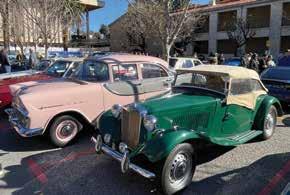


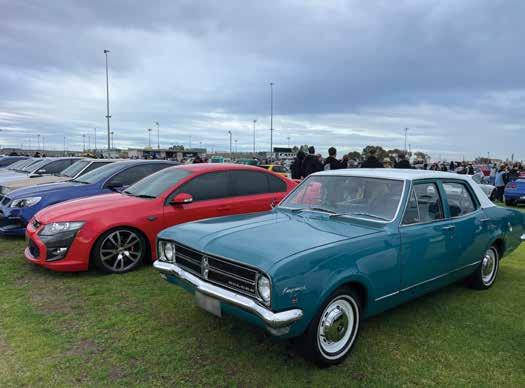
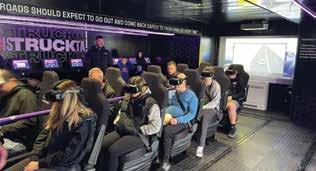
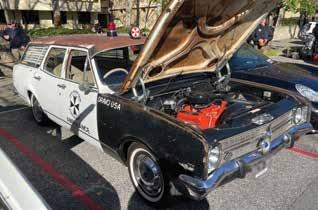





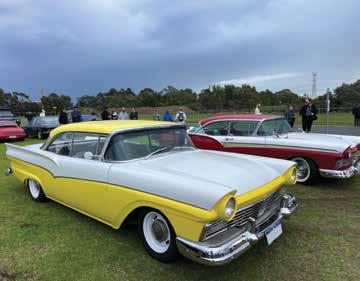

By Russell McKinnon

The Transport & Logistics Industry Skills Council warned in its 2011 Environmental Scan that more skilled workers would be lost to the mining and construction industries. Numbers moving to those industries were expected to escalate.
The average truck on Australian roads was 14 years old while Western Europe, North America and Japan has an average of eight years. Half of the trucks were not subject to modern emission standards. The Truck Industry Council reported that they emit on average the same particulate matter as 60 new Euro 5 trucks.
Work started on the 4.2km Great Eastern Highway upgrade that increased it to six lanes from Orrong Road to the airport. The road was servicing up to 55,000 vehicles a day.
The Prime Minister, Premiers and Chief Ministers — with the exception of WA — signed up to the National Heavy Vehicle Regulator and national truck laws in August. The laws were deemed unfavourable to WA. WARTA was endeavouring to protect the WA arrangements with its fatigue management programme under occupational safety and health and managed by Worksafe WA and to protect its heavy vehicle productivity variations.
The curfew on road trains and oversize loads using Great Eastern Highway through the Swan Valley was permanently lifted in October following a three-month trial from May 28.
There was a change of Minister for Transport with Troy Buswell succeeding Simon O’Brien. It was noted at the Passenger Services Division Annual General Meeting that with this change there came an attitude change from the Public Transport Authority (PTA). WA school buses transport children to 530 schools, covering 28 million kilometres annually. Secondary school principals have relinquished their role in the disciplinary side of school bus travel. Transfer points were being covered by wardens instead of school staff. However, PTA will still be the final arbiter in suspending students from bus travel. Members voted on a name change for the Division to BusWA and would move this recommendation forward to WARTA.
Long-term WARTA trainer Phil Loffman lost his battle with illness and it was decided to honour him with an award naming because of his efforts in the field of pilot training. He trained for 20 years, firstly with the Road Transport Industry Council of WA, then Transport Forum and finally with WARTA.
The trucking industry gained a two-year exemption from the Carbon Tax, which came into force on July 1. ATA lobbying gained the reprieve until July 1, 2014 after calling for a total exemption.
A report found that only about 30 percent of truck drivers wear seat belts. Increasing seat-belt use would prevent 37 percent of truck occupant fatalities, 36 percent of serious injuries and 22 percent of slight injuries.
There was a 60 percent improvement in the fatal-crash rate involving articulated trucks since 1982. A report on truck safety
concluded that most significant gains in truck safety during this period were due to broad road safety initiatives that have improved safety for all road users, particularly improvements to the road network (including divided highways and sealed shoulders), reduced speed limits and improvements in vehicle design.
Special Agent Austin Powers and his gorgeous assistant Felicity Shagwell compered the annual awards evening staged at the Esplanade Hotel, Fremantle in October. Minister for Transport Troy Buswell was in attendance and President Derek Nathan spoke of how the Federal Government’s National Regulation plan would disadvantage WA. He thanked Mr Buswell for the State Government not signing up to the plan. The following awards were made: CGU School & Community Bus Driver of the Year — Wendy Waterhouse of Gannaway’s Charter & Tours; Trevor Fehring, of Toll Mining Services — BP/Castrol Professional Truck Driver of the Year; Bridgette Peaurt of Toll Mining Services — NTI WA Transport Woman of the Year; Trevor Dawes, of T I Dawes and A S Irvine — Phil Loffman Memorial Award, Professional Pilot Operators of the Year; Daniel Pustkuchen, of Air Road Pty Ltd — TWUSUPER Future Leaders Award; Steve Post, of NTI — Most Outstanding Contribution to the WA Transport Industry.
Other Outstanding Contribution Awards in the centenary year went to: Fred Affleck, Chairman of the WA Freight & Logistics Council; the Cardacci Family, Centurion Transport; Kevin Cartwright, Whiteline Transport; Jim Currie, Energy Trucking; Nick D’Adamo, Key Bros Removals & Storage; Freight & Logistics Council of WA; Greg Martin, Chairman of the National Transport Commission; Bob Hancock, of Container Cargo Specialists; Howard Porter; and Allan Price, of Busselton Freight Services.



The Livestock and Rural Transport Association of Western Australia (Inc) is the only transport association in WA specifically representing rural transporters.
We are a strong voice for rural WA, ensuring that policy decisions support the viability and safety of rural transporters, primary industry and the communities they service.
Members of the Management Committee are hands on business people, most of whom would drive a truck weekly and travel on nearly every road in WA’s 150,000 km road network in the course of a year.
This close proximity between transporting operations and the advisory role means that representatives of the Association are at the coal face and as such are able to provide that all too rare practical hands on advice in committees, consultative forums and meetings.




